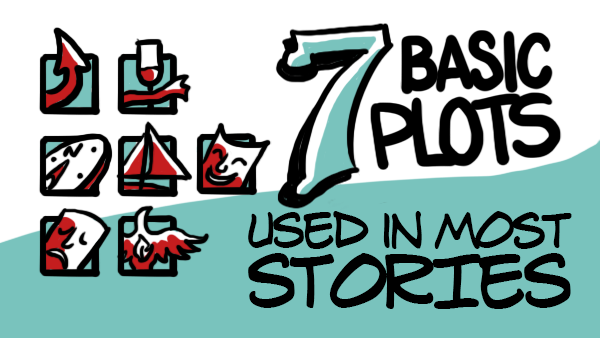Storytelling for video marketing doesn’t have to be boring. We have learned that most stories fit into a basic plot line. Using these basic plots as starting points for your script can help create exciting, shareable content that connects with your audience.
Published in 2004, Christopher Booker’s “The Seven Basic Plots: Why We Tell Stories” reportedly took him 34 years to write. A deep dive into the psychology behind how and why we tell stories, the book thoroughly details the seven different storytelling tropes, rooted in Jungian analysis. According to Booker, all the stories ever told can be divvied up across these seven categories:
1. Overcoming the Monster.
2. Rags to Riches.
3. The Quest.
4. Voyage and Return.
5. Comedy.
6. Tragedy.
7. Rebirth.
Is Booker right? It’s hard to say without knowing every story ever told since the dawn of time. While critical reactions to his theory were mixed, even a cursory examination of popular books, movies, and shows indicates that our natural instinct is to stick to a variation on one of these themes. Think about your favorite Oscar-nominated films- do they depend on one of the seven plots?
Let’s explore these archetypes and think about how we can use them when writing our video marketing content.

Overcoming the Monster
1. Overcoming the Monster
The first plot Christopher Booker covers in The Seven Basic Plots is Overcoming the Monster-perhaps the most basic plot of all, it’s also extremely effective. Familiar examples of this plot include Jurassic Park,Rocky, and Dracula. This plot features a hero/underdog up against an impossible evil, which can be either a figurative or literal monster. Booker lays it out in five stages, beginning with “Anticipation” (the hero beginning to understand the monster exists) and concluding with “Miraculous Escape” (the hero overcomes the monster with a combination of wit and bravery).
How can you write a video script using this plot?
Envision your topic as the“monster” you’re trying to defeat—maybe you’re grappling with organizational change or you need to roll out a new policy. Now think of yourself as the hero of your own video and plot out what happens between “Anticipation” and the “Miraculous Escape.”
After describing the monster in the Anticipation stage, write the “Dream” stage—where you encounter the monster and find yourself stronger than you ever dreamed you’d be. Next stage? “Frustration”—a conflict arises and you fail to overcome the monster. Just before the “Miraculous Escape,” you’ll have to navigate through the “Nightmare” stage, typically an epic battle where it seems all but inevitable that the monster will win. Yet you, the hero, will ultimately prevail.
This plot is perfect if you want your team to cheer you on or join with you to overcome your monster. It’s a timeless tale whether you’re talking about David and Goliath, or change management.

Rags to Riches
2. Rags to Riches
If hearing the term Rags to Riches prompts thoughts of glass slippers and midnight pumpkins, you’re not alone. Cinderella is by far the most common example of this basic plot. However, think outside the palace.
This plot serves to tell the story of anyone who has to work hard to overcome oppression or adversity, and is rewarded in the end. To apply this plot to a whiteboard video script, it’s key to think in metaphorical terms.
A Rags to Riches story begins with a protagonist in dire straits, and ends with them greatly enriched and empowered. There is usually an initial catalyst for change that drives the story towards its rewarding conclusion.
For the purposes of a video script, this plot is great for showing a journey from struggle to success. For example, maybe you’re selling an inexpensive, user-friendly home security software. You can describe the plight of someone who is dealing with the threat of theft, intrusion, and inconvenience. Then introduce your saves-the-day solution, and finally illustrate their newly empowered existence—all thanks to your software. Voila!
Your Rags to Riches story doesn’t have to be a fairy tale to end happily ever after.
3. The Quest
Star Wars. Homer’s Odyssey. The Princess Bride. Siddhartha. The Wizard of Oz. The Goonies. What do all of these stories have in common?

The Quest
They’re all excellent examples of the third type of plot in Booker’s The Seven Basic Plots: The Quest.
Quest plots typically involve a hero or group of heroes who embark upon a journey propelled by some type of “holy grail” – whether it be true love, finding their way home, or bringing peace to the galaxy. Though they encounter obstacles and adversity along the way, and face tests of their character and strength, our heroes emerge victorious upon achieving their goal and finding their elusive holy grail.
How to apply this classic trope to your video script? The answer is simple, and if you’ve developed a marketing strategy, you’ve probably already thought of it.
Whatever you’re offering, whether it’s a service, a software, or a software as a service, write a script that shapes it into something highly valuable and sought after.
Describe the challenges your clients (the heroes of this script) might face as they travel towards your solution, and detail how, by the end of the quest, they’ll possess a powerful and mighty tool to combat future challenges.
This type of plot is all about building value into your topic, and knowing the pain points it can alleviate. So gather your value proposition, examine your clients’ needs, and be prepared for solution-seekers to journey your way. May the force be with you!
4. Voyage and Return

Voyage and Return
Ever fallen down a rabbit hole? Gotten into a hot tub and been transported back to high school? Stepped into a closet and wandered into a forest ruled by a mighty lion? These are plot points in famous examples of Booker’s fourth plot point, Voyage and Return (Alice in Wonderland, Hot Tub Time Machine, and The Chronicles of Narnia, respectively).
This type of plot is common in children’s tales as it leans heavily on allegory- fantastical events transpire as the protagonist travels (often magically) to a distant and different land, and returns a changed person, rich with experience and wiser about themselves and the world they actually inhabit, due to the lessons learned on their voyage.
This plot happens to be a perfect fit for a type of script we at TruScribe are quite familiar with- the metaphor.
It’s simple to write a video script in the voyage and return format if you can imagine a place, land, or even world designed solely to tell your story.
Talking wealth management? Maybe your hero topples into a bank vault, and wakes up surrounded by dollars come to life- there to take him on a trek through the dangerous Forest of Finance.
In HR? Perhaps your character falls asleep at their desk, only to dream of a magical office building where insults have come to life to teach him how to combat harassment. He returns a changed employee, ready to teach his colleagues. This type of plot is imaginative and powerfully memorable. Use it when you’re trying to communicate a broad or controversial topic that requires some finesse.
And if you find yourself sitting at a table with a bunch of talking animals, drinking tea and unsure of the way back to where you started (metaphorically speaking, of course) let us know- our scriptwriters would be happy to lend a hand.
5. Comedy
Comedy as a plot isn’t about slipping on a banana peel or having a great punchline. It’s more about a series of confusing, awkward, or otherwise comical events within a lighthearted tale (often a romance) about people trying to triumph but having numerous laughable difficulties finding their way. Shakespeare’s Much Ado About Nothing is a classic example of a comedy plot. As in many of the other basic plots, first the stage is set and the stakes are raised. In the comedy plot, next comes a period of confusion and/or isolation before the hero ultimately triumphs in the end. Think Bridget Jones’s Diary, Forgetting Sarah Marshall, Ocean’s Eleven, or Clerks.

Comedy
The main thing to remember when trying to use comedy as your video plot is to keep it light hearted throughout. Try not to be gimmicky, but think of a fun way to showcase your product or service that will set up a couple obstacles between your audience and receiving it—obstacles that might be hilarious to watch someone overcome. People want to root for your main character, and a comedy always has a happy ending. So no matter what trials and tribulations you may throw into the story to introduce elements of confusion or isolation, be sure the ending results in a smile.
6. Tragedy

Tragedy
Booker’s sixth basic plot is likely the darkest out of all Seven Basic Plots. The Tragedy plot is, well, quite tragic, and the protagonist of this plot may be good, but they likely have nefarious characteristics—they may even be a full-fledged villain. Generally these traits emerge as a result of the first stage of the Tragedy plot, which surrounds temptations. The hero attempts to attain something forbidden or discouraged, which will lead the plot down a path of setbacks, a dramatic downward spiral, and finally the story comes to a sad conclusion, one which often includes tragic consequences for the hero. The most notorious example of this plot is Romeo and Juliet, but you might recognize the Tragedy plot in modern tales as well, like Goodfellas, Bonnie and Clyde, True Romance, and Breaking Bad.
You may not want to turn to the dark side in a whiteboard video, but if you can think of a fatal flaw that you’d like to expose, here’s a time where you can use your video script to illuminate a darker or very serious topic related to your goal.
For instance, if you are marketing an innovative treatment for a deadly disease, you can portray the disease itself as the protagonist of your tragedy. The mood tends to stay dark throughout a tragic video, and that often prompts deeper thought and contemplation—which can prompt your viewers to turn to your solution.
7. Rebirth

Rebirth
Much like spring, this plot is all about renewal, transformation, and new beginnings. The hero of a rebirth plot is often misguided, and changes for the better under the guidance of another, wiser character, or because they are inspired by love, family, or the greater good to become a better person. The rebirth plot is seen in The Lion King, The Grinch Who Stole Christmas, A Christmas Carol, Shawshank Redemption, Despicable Me, and The Secret Garden.
To rework this plot into a script, you’ll likely want to take the approach of the trusted guide. Explain the redeeming qualities that can transform your viewer’s world. Build trust through enumerating your solutions, and explain how they’ll lead your viewer away from a poor situation into a whole new world where they are freed from stress and can reinvent their business, their health, or themselves as a result. This plot provides a wonderful structure for illustrating change!
Now that you have a thorough understanding of the 7 Basic Plots, how will you tell your story?
And if you are looking for more guidance on writing your script, check out this post on Common Fears of Scriptwriting.

